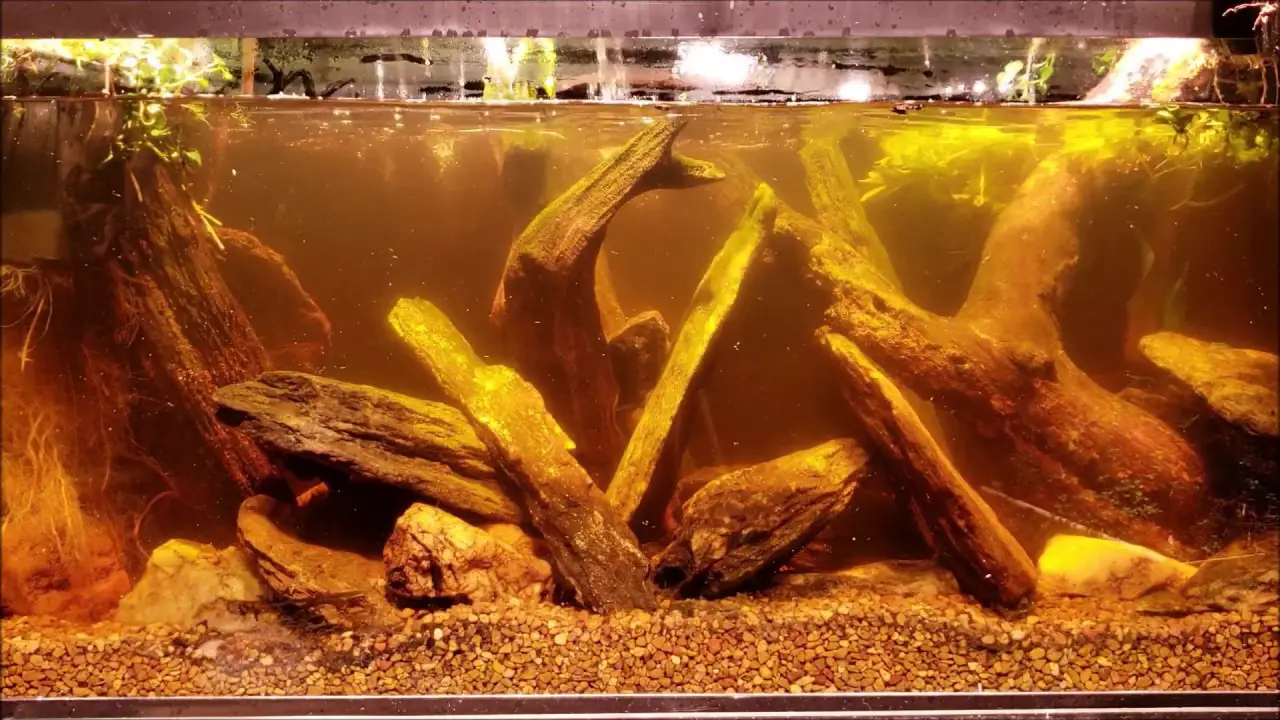Are you tired of cloudy aquarium water? Do you want to provide your fish with a clean and healthy environment? One of the common culprits of discolored water in aquariums is tannins. These organic compounds are released by driftwood, leaves, and other natural materials in the tank. Luckily, there are several effective methods to remove tannins from aquarium water and restore the clarity of your tank.
In this article, we will explore the different ways to eliminate tannins from your aquarium water. We will look at the causes and effects of tannins on fish and plants, as well as the benefits of having clear water in your tank. Whether you are a beginner or an experienced aquarist, you will find valuable tips and tricks to improve the quality of your aquarium water. So, let’s dive in and learn how to keep your tank crystal clear!
Tannins can make your aquarium water look like tea and may harm your fish. To remove them, try one of these methods:
– Perform regular water changes
– Use activated carbon or Purigen in the filter
– Boil and soak driftwood before adding it to the tank
– Add Indian almond leaves or catappa extract to the water
– Use a protein skimmer if you have a saltwater aquarium.

Removing Tannins From Aquarium Water: A Comprehensive Guide
Aquariums are a great source of relaxation and entertainment, but sometimes, the water can become discolored due to tannins. Tannins are organic compounds that are released into the water by decaying plants, wood, and other organic matter. While tannins are not harmful to fish, they can make the water look unsightly and affect the pH level of the aquarium. In this article, we will discuss various methods for removing tannins from aquarium water.
Method 1: Activated Carbon
Activated carbon is a popular method for removing tannins from aquarium water. It works by absorbing the tannins, which are then trapped in the carbon’s pores. To use activated carbon, simply place it in a filter bag and add it to your aquarium filter. The carbon should be replaced every four to six weeks, or when it becomes saturated.
One potential downside to using activated carbon is that it can also remove beneficial trace elements from the water. To avoid this, be sure to add a trace element supplement to your aquarium after using activated carbon.
Method 2: Water Changes
Performing frequent water changes can also help to reduce tannins in your aquarium water. By removing some of the water and replacing it with fresh, clean water, you dilute the concentration of tannins in the tank. This method is especially effective if the tannins are only present in small amounts.
However, water changes can be stressful for fish and other aquatic animals, so it is important to follow proper water change procedures. Be sure to use a dechlorinator to remove any harmful chemicals from tap water before adding it to your tank.
Method 3: Indian Almond Leaves
Indian almond leaves are a natural way to reduce tannins in your aquarium water. These leaves contain tannin-reducing compounds that can help to clear up discolored water. Simply add a few leaves to your tank, and they will begin to release their tannin-reducing properties into the water.
In addition to reducing tannins, Indian almond leaves can also have other benefits for your aquarium. They can help to create a natural environment for your fish and provide a food source for some species.
Method 4: Peat Moss
Peat moss is another natural way to remove tannins from aquarium water. It works by absorbing the tannins, similar to how activated carbon works. To use peat moss, simply place a small amount in a mesh bag and add it to your filter. The peat moss should be replaced every four to six weeks.
One potential downside to using peat moss is that it can lower the pH level of your aquarium water. If you have fish or plants that require a specific pH level, be sure to monitor the pH closely when using peat moss.
Method 5: Boiling Driftwood
Driftwood is a common source of tannins in aquariums. While some aquarists prefer the natural look that driftwood provides, others may want to remove the tannins it releases. One way to do this is by boiling the driftwood before adding it to your tank.
To boil driftwood, simply place it in a pot of water and bring it to a boil. Let it boil for 10-15 minutes, then remove it from the pot and let it cool. This should help to remove some of the tannins and make the wood safe for aquarium use.
Method 6: Chemical Treatments
There are various chemical treatments available that can help to remove tannins from aquarium water. These treatments work by binding with the tannins and removing them from the water. However, it is important to use these treatments carefully and follow the instructions closely, as some can be harmful to fish and other aquatic animals.
One popular chemical treatment for tannins is Seachem Purigen. This product is a synthetic adsorbent that can remove not only tannins but also other impurities from the water.
Method 7: UV Sterilizers
UV sterilizers are another method for removing tannins from aquarium water. These devices use ultraviolet light to kill bacteria, viruses, and other harmful organisms in the water. While they are not specifically designed to remove tannins, they can help to reduce the overall organic load in the tank, which can lead to clearer water.
However, UV sterilizers can also kill beneficial bacteria in the tank, so it is important to use them carefully. They should not be used as a long-term solution for tannin removal.
Method 8: Reverse Osmosis
Reverse osmosis is a method for purifying water that can also help to remove tannins. This process involves forcing water through a semi-permeable membrane that filters out impurities, including tannins. Reverse osmosis systems can be purchased for home use and can be a good long-term solution for tannin removal.
However, reverse osmosis systems can be expensive and require regular maintenance. They may not be practical for all aquarium owners.
Method 9: Benefits of Removing Tannins
While tannins are not harmful to fish, removing them from aquarium water can have several benefits. Clearer water can improve the visibility of your fish and plants, making the tank more aesthetically pleasing. Removing tannins can also help to maintain a stable pH level in the tank, which is important for the health of your aquatic animals.
Method 10: Tannins vs. Humic Substances
It is important to note that not all organic compounds in aquarium water are tannins. Humic substances are another type of organic matter that can affect the color and quality of the water. While tannins are a type of humic substance, not all humic substances are tannins.
To determine whether the discoloration in your aquarium water is due to tannins or other humic substances, you can perform a simple test. Fill a clear container with water from your aquarium and hold it up to a light source. If the water appears yellow or brown, it is likely due to tannins. If the water appears clear but has a greenish tint, it may be due to other types of humic substances.
In conclusion, there are several methods for removing tannins from aquarium water. Whether you prefer natural methods or chemical treatments, it is important to choose a method that works best for your aquarium and follow proper procedures to ensure the health of your fish and other aquatic animals.
Frequently Asked Questions
In this section, we will address some of the most commonly asked questions about how to remove tannins from aquarium water.
What are tannins and why do they turn aquarium water yellow?
Tannins are organic compounds that are released by decaying plant matter such as leaves, wood, and peat. They can turn aquarium water yellow or brown and can also lower the pH level. Tannins are not harmful to fish, but they can make the water look unappealing.
To remove tannins, you need to perform regular water changes and use activated carbon or some other type of chemical filtration.
What is activated carbon and how does it remove tannins?
Activated carbon is a form of carbon that has been treated with oxygen to open up millions of tiny pores between the carbon atoms. These pores adsorb (attract and hold) organic molecules, including tannins, from the water. Activated carbon can be used in a filter or added directly to the aquarium.
It is important to note that activated carbon needs to be replaced regularly to ensure it continues to work effectively. Follow the manufacturer’s instructions for how often to replace the activated carbon.
Can plants help remove tannins from aquarium water?
Yes, live plants can help to reduce the amount of tannins in aquarium water. Plants use tannins as a source of carbon for photosynthesis, which can help to reduce the concentration of tannins in the water column. However, if the tannin concentration is too high, plants may not be able to absorb all of the tannins.
It is also important to note that some plants, such as those that naturally release tannins, may actually contribute to the discoloration of the water. Choose plants carefully and monitor the water regularly to ensure the tannin levels are under control.
What other types of chemical filtration can be used to remove tannins?
In addition to activated carbon, other types of chemical filtration can be used to remove tannins from aquarium water. Some examples include ion exchange resins, which exchange ions in the water for other ions, and poly-fiber pads, which mechanically trap organic molecules including tannins.
It is important to select the right type of chemical filtration for your aquarium and to follow the manufacturer’s instructions for use and replacement.
Can UV sterilizers remove tannins from aquarium water?
UV sterilizers use ultraviolet light to kill bacteria, viruses, and other microscopic organisms in the water. While a UV sterilizer will not remove tannins directly, it can help to prevent the growth of bacteria and fungi that can contribute to the breakdown of plant matter and the release of tannins into the water.
Using a UV sterilizer in combination with other forms of filtration, such as activated carbon, can help to reduce the concentration of tannins in aquarium water.

Remove Yellow Tannin Water from Aquarium
In conclusion, removing tannins from aquarium water is important for the health and well-being of your aquatic pets. These organic compounds can cause discoloration and acidity in the water, making it difficult for fish and plants to thrive. Fortunately, there are several effective methods for removing tannins from your aquarium water.
Firstly, using activated carbon is a simple and effective way to remove tannins from the water. This material can be added to your filter or placed in a mesh bag and submerged in the tank. It works by adsorbing the tannins and other organic compounds, leaving your water clear and healthy.
Secondly, water changes can also help to reduce tannin levels in your aquarium. By replacing a portion of the water each week, you can dilute the concentration of tannins and other pollutants in the tank. This will help to keep your water clear and balanced, promoting a healthy environment for your aquatic pets.
Lastly, it’s important to address the source of the tannins in your aquarium water. If you have driftwood or other organic materials in your tank, they may be leaching tannins into the water. Consider removing these items or soaking them in water prior to adding them to your tank to reduce the tannin content.
Overall, removing tannins from your aquarium water is an important step in maintaining a healthy and thriving aquatic environment. By using activated carbon, performing regular water changes, and addressing the source of tannins in your tank, you can keep your water clear and your fish and plants happy and healthy.
